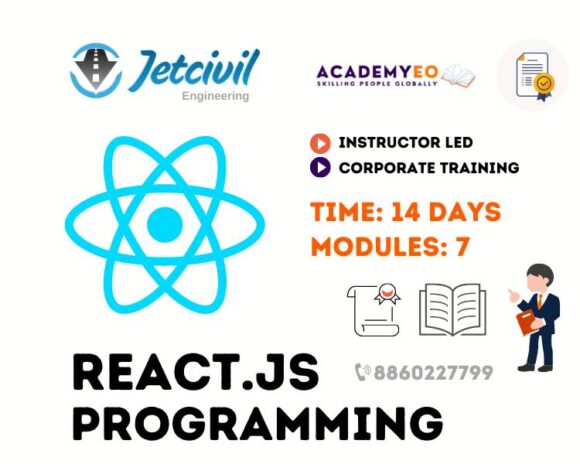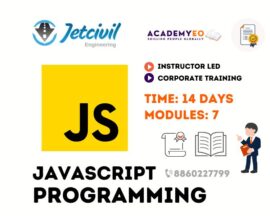ReactJs Programming & Mastering React.js
₹ 10,000.00
- Time: 14 Days (Daily 1 hr)
- Lectures: 7 Modules
- Instructor Led Course
- Learning from Academyeo
- Certificate from Academyeo
- Mini Project & Assessment

- Description
- Curriculum
- Instructor
Description
ReactJs Programming: React is an open-source, front end, JavaScript library for building user interfaces or UI components. It is maintained by Facebook and a community of individual developers and companies. ReactJs Programming can be used as a base in the development of single-page or mobile applications. In this course instructor led training would cover up the following topics:
- Getting Started
- ES6 Refresher
- Components
- Composing Components
- Pagination, Filtering, and Sorting
- Routing
- Forms
- Calling Backend Services
- Authentication and Authorization
- Deployment
- Advanced Topics
React (also known as React.js or ReactJS) is an open-source, front end, JavaScript library[3] for building user interfaces or UI components. It is maintained by Facebook and a community of individual developers and companies.[4][5][6] React can be used as a base in the development of single-page or mobile applications. However, React is only concerned with state management and rendering that state to the DOM, so creating React applications usually requires the use of additional libraries for routing.[7][8] React Router[9] is an example of such a library.
Declarative
React makes it painless to create interactive UIs. Design simple views for each state in your application, and React will efficiently update and render just the right components when your data changes. Declarative views make your code more predictable and easier to debug.
Component-Based
Build encapsulated components that manage their own state, then compose them to make complex UIs. Since component logic is written in JavaScript instead of templates, you can easily pass rich data through your app and keep state out of the DOM.
Learn Once, Write Anywhere
We don’t make assumptions about the rest of your technology stack, so you can develop new features in React without rewriting existing code. React can also render on the server using Node and power mobile apps using React Native.
A Simple Component
React components implement a render() method that takes input data and returns what to display. This example uses an XML-like syntax called JSX. Input data that is passed into the component can be accessed by render() via this.props.
Curriculum
- Getting Started
- ES6 Refresher
- Components
- Composing Components
- Pagination, Filtering, and Sorting
- Routing
- Forms
- Calling Backend Services
- Authentication and Authorization
- Deployment
- Advanced Topics
Instructor
Jaswinder Singh – Post Graduate M.tech Degree Holder in Data Science, Machine Learning
















